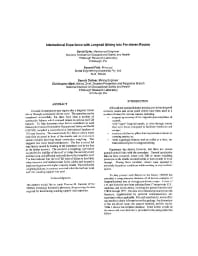Mining Publication: International Experience with Longwall Mining into Pre-Driven Rooms
Original creation date: January 1998
Authors: DC Oyler, RC Frith, DR Dolinar, C Mark
NIOSHTIC2 Number: 20000122
Proc 17th Conference on Ground Control in Mining, S. S. Peng. C. T. Holland, eds., 1998 Aug, Morgantown, WV, West Virginia University, 1998; :44-53
Unusual circumstances may require that a longwall retreat into or through a previously driven room. The operation can be completed successfully, but there have been a number of spectacular failures which exposed miners to serious roof fall hazards. To help determine what factors contribute to such failures, the National Institute for Occupational Safety and Health (NIOSH) compiled a comprehensive international database of 130 case histories. The case included five failures where major rock falls occurred in front of the shields, and six even more serious failures involving major overburden weighting. This suggests two room failure mechanisms. The first is a roof fall type failure caused by loading of the immediate roof at the face as the fender narrows. The second is a weighting type failure caused by the inability of the roof to bridge the recovery room and face area, and affecting rock well above the immediate roof. The data indicate that the roof fall type of failure is less likely when intensive roof reinforcement (bolts, cables, and trusses) is employed together with higher-capacity shields. The overburden weighting failures, in contrast, occurred when the roof was weak and little standing support was used.

NIOSHTIC2 Number: 20000122
Proc 17th Conference on Ground Control in Mining, S. S. Peng. C. T. Holland, eds., 1998 Aug, Morgantown, WV, West Virginia University, 1998; :44-53
- Current trends in Reducing Ground Fall Accidents in US Coal Mines
- Current Trends in Reducing Ground Fall Accidents in US Coal Mines
- Dynamic Failure in Deep Coal: Recent Trends and a Path Forward
- Horizontal Stress and Longwall Headgate Ground Control
- Multiple Seam Longwall Mining in the U.S. - Lessons for Ground Control
- Overview of Coal Mine Ground Control Issues in the Illinois Basin
- Proceedings: New Technology for Ground Control in Multiple-seam Mining
- Roof and Rib Hazard Assessment for Underground Stone Mines
- Stability Mapping to Examine Ground Failure Risk: A Field Study at a Limestone Mine
- A Study of the Ground Control Effects of Mining Longwall Faces Into Open or Backfilled Entries